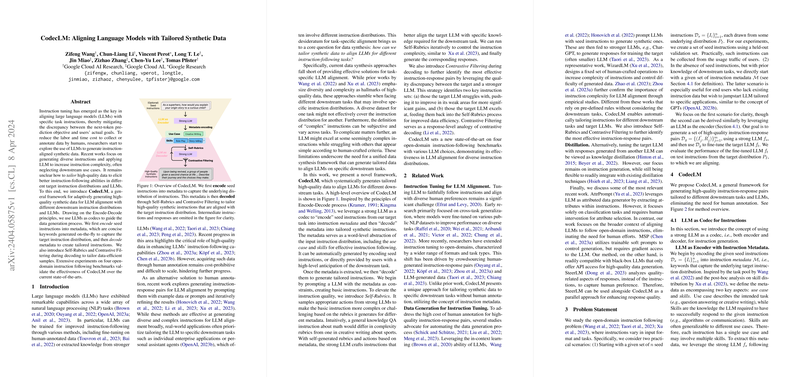Introducing CodecLM: A Framework for Tailoring High-Quality Synthetic Data for LLM Alignment
Overview of CodecLM
Recent advances in LLMs have highlighted the importance of instruction tuning to align LLMs with specific task instructions. A pivotal challenge in this line of work is generating high-quality synthetic data that closely matches the target instruction distributions and LLMs, a task that CodecLM approaches with a novel methodology. CodecLM operates on the principles of Encode-Decode, using LLMs as codecs to navigate the data generation process, starting from encoding seed instructions into metadata and subsequently decoding this metadata to produce tailored instructions. Enhanced by Self-Rubrics and Contrastive Filtering, CodecLM systematically refines the generated data, ensuring it is both diverse and aligned with the designated tasks.
Encoding Seed Instructions into Metadata
CodecLM introduces an innovative step of encoding seed instructions into concise keywords that encapsulate the target instruction distribution. This metadata, focusing on use cases and required skills, enables a generalizable yet precise formulation of the instruction's intent and complexity level. Such a method not only streamlines the generation process but also sidesteps the labor-intensive requirement for vast annotated datasets.
Decoding Metadata to Generate Tailored Instructions
With the metadata in place, CodecLM decodes it to craft basic instructions, which are further refined through the Self-Rubrics process. This allows for adapting the instruction complexity based on the metadata, ensuring the synthetic instructions are both challenging and relevant to the targeted downstream task. The iterative nature of this process, informed by the generated rubrics and actions, lends a dynamic adaptability to the system, allowing for the generation of instructions that are finely tuned to the model's needs.
Self-Rubrics and Contrastive Filtering
The Self-Rubrics mechanism in CodecLM empowers the system to evaluate and adjust the complexity of instructions dynamically, catering to a wide range of downstream tasks. Following this, Contrastive Filtering helps select the most effective instruction-response pairs by estimating the target LLM's performance gap compared to a stronger LLM model. This not only identifies areas where the target LLM could improve but also maximizes the instructional value of each data point used in tuning.
Empirical Validation and Implications
Extensive experiments across four open-domain instruction-following benchmarks demonstrate CodecLM's superiority over existing state-of-the-art methods. By setting new benchmarks, CodecLM not only underscores the significance of custom-tailored synthetic data but also opens new avenues in instruction tuning for LLMs across different sizes and capabilities.
The implications of CodecLM extend beyond immediate practical applications in LLM tuning. Theoretically, it presents a refined understanding of how LLMs can be tailored for specific tasks through targeted synthetic data generation. This adaptability foretells a future where LLMs can be more efficiently and effectively specialized, reducing reliance on extensive human-annotated datasets—a notable advance in the pursuit of more autonomous and agile AI systems.
Future Directions
CodecLM's architecture invites further exploration into enhancing the quality and applicability of synthetic data for LLM alignment. Future work might include refining the metadata definition to encompass broader or more nuanced aspects of instructions, developing more sophisticated mechanisms for Self-Rubrics and Contrastive Filtering, and integrating CodecLM with other alignment techniques for synergistic effects. As LLMs continue to evolve, frameworks like CodecLM will play a crucial role in harnessing their potential for a wide array of applications, marking a significant step forward in the field of generative AI and machine learning.
